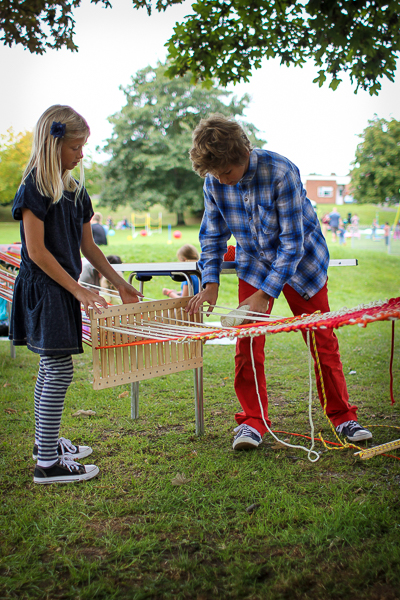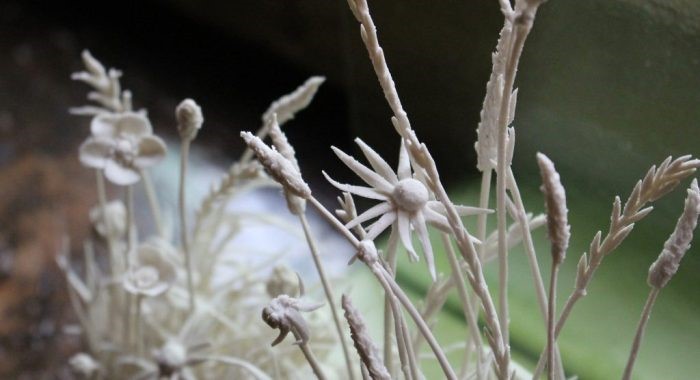“In the end, you're only as good as your last project, so there's always that pressure to keep going.”
Carol Carey spent 20 years working in the field of design, urban/spatial design and public art. For the last 18 years, she has been working in the visual arts sector. As Creative Director for Somerset Art Works, Carol Carey is responsible for the overall management, development and forward planning of the organisation’s core activities and the vital role of sourcing and maintaining funding streams. She oversees the development of the regional and national profile of the organisation, building relationships with partners in art and non-art sectors.

Photo credit: Carol Carey - Somerset Artworks - Artist Dorcas Casey commissioned to lead creative workshops with students @Jasper Casey
Tell us about your work and practice.
We have four strands in our practice at Somerset Art Works. Our artist development strand, where we give bursaries to four graduates a year as a stepping stone post their either BA or MA. The community and commissions strand, where we develop projects with non-arts partners, such as the National Trust, wildlife trusts and museums. The education, engagement and learning strand, which covers our relationship with schools and our family-friendly inter-generational offer, and which predominantly focuses around making skills.
The fourth strand is open studios and festivals. Every other year we have an open studio event, where about 250 studios, ranging from fine art to pottery, open. We’re focused on encouraging creativity in the wider community and in the artists community. Our artist membership scheme includes about 450 members, who are entitled to come together in various network groups, and also have the opportunity to apply for what we call pair-up programmes, partnering with another maker or artist, be they local, national or international. Every other year we also run a festival where we showcase our major commissions, which usually have a link to our education programmes. Some of the artists who participate are Somerset-born, but then go on to have international career, and some of them are national artists that we bring in, and we have an aspiration to bring an international artist as well - it’s sort of the next line for us, which is why I applied for Crafting Futures too.
How do you think international collaboration will impact your work?
I think international collaboration can really help. We actually have more Romanian residents in Somerset now, who are very much settled in their communities, so there's potential in terms of reaching communities here in Somerset.
I'm also very interested to widen the ability of international artists to come to Somerset to make crafts. We've looked at various of the Creative Europe programmes, but we're small, so it's quite difficult for us to make that step into what is essentially a programme that's larger than we've been able to accommodate, although we've now increased our capacity to look at more complex bids and more complex arrangements.
In the end, you're only as good as your last project, so there's always that pressure to keep going.

Photo credit: Carol Carey - Somerset Artworks - Community Priorswood Our Place engagement @Nisha Haq
What are the main challenges in your work?
At this time, our main challenge is probably funding. We've got some long-standing partnerships, but it's been quite a nervous time waiting to see whether those partnerships are going to keep going. I think in the UK we depend to a certain extent on trusts and foundations, and we know that's going to be quite difficult in the next 2-5 years, it is going to be challenging. We never seem to be short of ideas, a lot of our work focuses around health and wellbeing, and nature, and those connections, and connection to nature. We have an abundance of natural materials which have been industrialized in Somerset over the centuries, it's a county with a lot of potential. We’ve got good experience growing partnerships, so the challenge and the work ahead is just to find the right funding streams to allow us to continue them.
Have you learned anything surprising about Romanian craft? (What?)
I was fascinated by the canoe, and by Corizom, I thought the work they were doing was superb. I could see links to the work done in relation to high-end fashion - we have a couple in Somerset who started using the bolts of fabric that international luxury goods company Mulberry did not use for their collection, and they designed their own very beautiful natural materials and linens. I could see various links to different makers here in Somerset, all sorts of different parallels. And I was just so impressed, because I feel we've got more to learn from Romania.

Photo credit: Carol Carey - Somerset Artworks - Ceramics for Landscape of Objects Ford Abbey by Katie Spragg @Davina Jelley
How do you see the future of your work and of crafts in this post Covid-19 world?
For us, going forward, connection with material and making is a really strong part of growing our practice, particularly with natural materials, given that we've got amazing natural resources in Somerset. But also with a focus on reinventing, on taking some of the traditional basic skills and finding ways to reapply them in a contemporary sense.
I think the resurgence of craft has happened already. There has been a definite surge in interest, not just from collectors, but also with everyone else wanting to make things. And it doesn't seem that that's going to go away anytime soon. All these things obviously have fashions, and we've had quite a resurgence of interest in ceramics and pottery and jewelry. There's also an interest in a lot of repair and recycling as well, and using different materials, and using plastics in different ways. I think that will continue, and it's going to be strong.
What advice would you give to practitioners looking to adapt during these times?
In the UK we have a tradition of what we call second-careers - people who have been in a profession and then retrain. And very often, they retrain into craft. They're the lucky ones, very often, because they have very good business skills.
But I think a lot of artists and craft practitioners need to improve their digital skills. We're running a series around improving these skills, looking at selling platforms, websites, social media. This side is really important. We've probably got about 20 people on each of the 10 workshops that we're running already, so I think people are realizing that they've got to get these skills. They've got to take better photographs of their work, they've got to be more connected with their market. `
Also, making market-ready products is important, and a challenge which I think needs a more strategic lead - the notion of getting markets ready, or getting ready for a market. People are shopping more locally again, especially when it comes to food, and I could see that happening with homeware as well, so there is potential there.
Crafting Futures is a global British Council programme building a positive future by unlocking craft’s unique potential to inspire people around the globe. The programme celebrates the value of craft in our history, culture and world today.
Through making and international collaboration, Crafting Futures brings together craft practitioners, designers and organisations from around the world to explore possibilities for this future together.
Launched in Romania in 2020, Crafting Futures brings together six craft professionals from the United Kingdom and organisations, designers, artists and craftivists in Romania, aiming to support the development of shared learning and traditional, sustainable craft and design practice.
https://www.britishcouncil.ro/en/programmes/arts/crafting-futures
